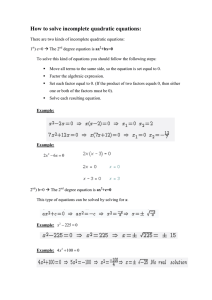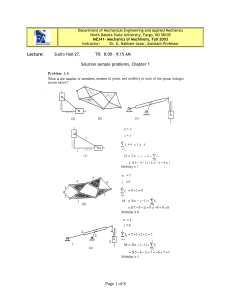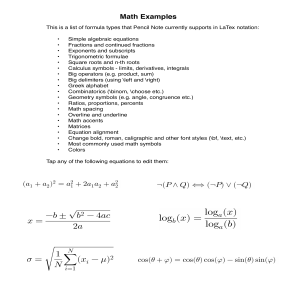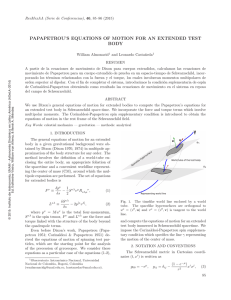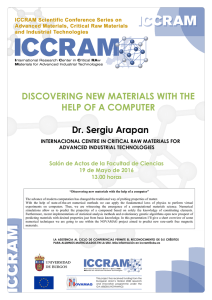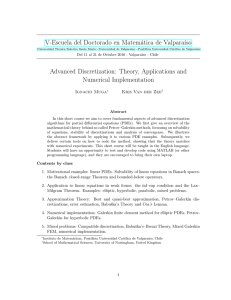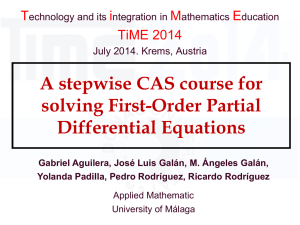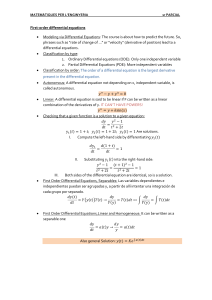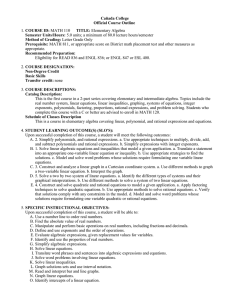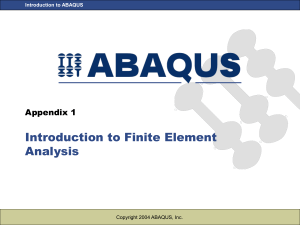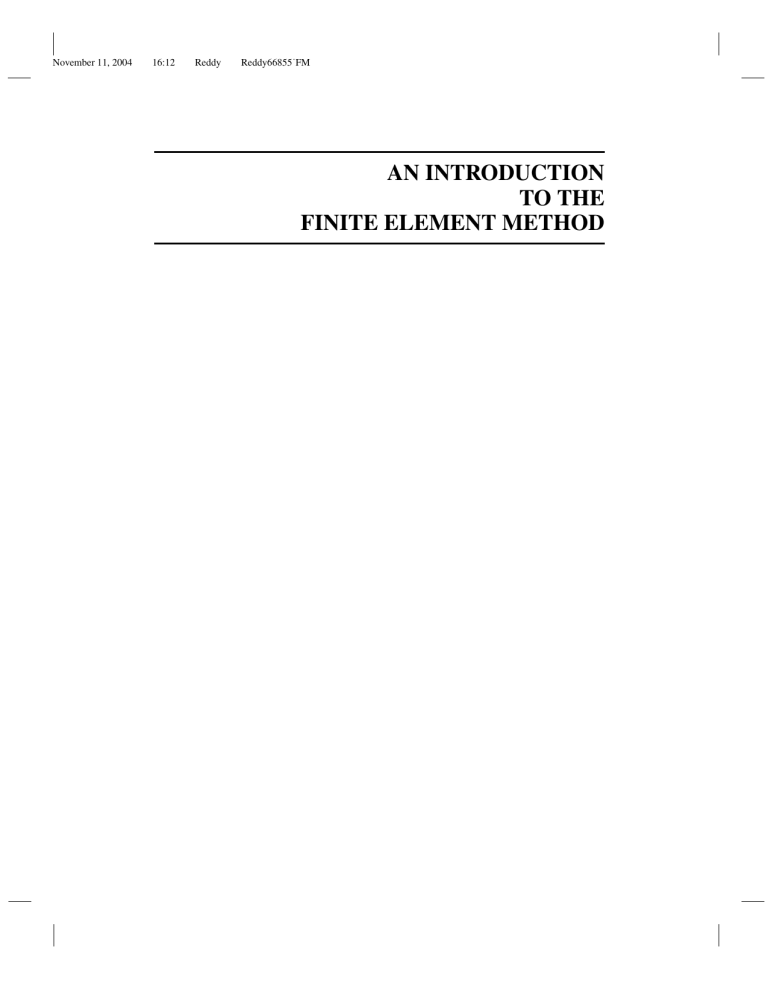
November 11, 2004 16:12 Reddy Reddy66855˙FM AN INTRODUCTION TO THE FINITE ELEMENT METHOD November 11, 2004 16:12 Reddy Reddy66855˙FM McGraw-Hill Series in Mechanical Engineering Alciatore and Histand: Introduction to Mechatronics and Measurement Systems Anderson: Computational Fluid Dynamics: The Basics with Applications Anderson: Fundamentals of Aerodynamics Anderson: Introduction to Flight Anderson: Modern Compressible Flow Barber: Intermediate Mechanics of Materials Beer/Johnston: Vector Mechanics for Engineers Beer/Johnston/DeWolf: Mechanics of Materials Budynas: Advanced Strength and Applied Stress Analysis Cengel and Boles: Thermodynamics: An Engineering Approach Cengel and Turner: Fundamentals of Thermal-Fluid Sciences Cengel: Heat Transfer: A Practical Approach Cengel: Introduction to Thermodynamics & Heat Transfer Crespo da Silva: Intermediate Dynamics Dieter: Engineering Design: A Materials & Processing Approach Dieter: Mechanical Metallurgy Doebelin: Measurement Systems: Application & Design Dunn: Measurement & Data Analysis for Engineering & Science EDS, Inc.: I-DEAS Student Guide Hamrock/Schmid/Jacobson: Fundamentals of Machine Elements Heywood: Internal Combustion Engine Fundamentals Holman: Experimental Methods for Engineers Holman: Heat Transfer Hutton: Fundamentals of Finite Element Analysis Kays/Crawford/Weigand: Convective Heat and Mass Transfer Meirovitch: Fundamentals of Vibrations Norton: Design of Machinery Palm: System Dynamics Reddy: An Introduction to the Finite Element Method Schaffer et al.: The Science and Design of Engineering Materials Schey: Introduction to Manufacturing Processes Shames: Mechanics of Fluids Shigley/Mischke/Budynas: Mechanical Engineering Design Smith: Foundations of Materials Science and Engineering Suryanarayana and Arici: Design and Simulation of Thermal Systems Turns: An Introduction to Combustion: Concepts and Applications Ugural: Mechanical Design: An Integrated Approach Ullman: The Mechanical Design Process White: Fluid Mechanics White: Viscous Fluid Flow Zeid: Mastering CAD/CAM November 11, 2004 16:12 Reddy Reddy66855˙FM An Introduction to the Finite Element Method Third Edition J. N. REDDY Department of Mechanical Engineering Texas A&M University College Station, Texas, USA 77843 Boston Burr Ridge, IL Dubuque, IA Madison, WI New York San Francisco St. Louis Bangkok Bogotá Caracas Kuala Lumpur Lisbon London Madrid Mexico City Milan Montreal New Delhi Santiago Seoul Singapore Sydney Taipei Toronto November 11, 2004 16:12 Reddy Reddy66855˙FM AN INTRODUCTION TO THE FINITE ELEMENT METHOD, THIRD EDITION Published by McGraw-Hill, a business unit of The McGraw-Hill Companies, Inc., 1221 Avenue of the Americas, c 2006, 1993, 1984 by The McGraw-Hill Companies, Inc. All rights reserved. New York, NY 10020. Copyright No part of this publication may be reproduced or distributed in any form or by any means, or stored in a database or retrieval system, without the prior written consent of The McGraw-Hill Companies, Inc., including, but not limited to, in any network or other electronic storage or transmission, or broadcast for distance learning. Some ancillaries, including electronic and print components, may not be available to customers outside the United States. This book is printed on acid-free paper. 1 2 3 4 5 6 7 8 9 0 QPF/QPF 0 9 8 7 6 5 4 ISBN 0-07-246685-5 Senior Sponsoring Editor: Suzanne Jeans Developmental Editor: Amanda J. Green Senior Marketing Manager: Mary K. Kittell Project Manager: Peggy S. Lucas Senior Production Supervisor: Kara Kudronowicz Media Technology Producer: Eric A. Weber Senior Coordinator of Freelance Design: Michelle D. Whitaker Cover Designer: Rebidas Design & Associates Lead Photo Research Coordinator: Carrie K. Burger Supplement Producer: Brenda A. Ernzen Compositor: International Typesetting and Composition Typeface: 10 Computer Modern (cmr 10) Printer: Quebecor World Fairfield, PA (USE) Cover Images: Pinched Cylinder image is generated by the data included in the paper “Least-squares finite element formulation for shear-deformable shells,” by J. P. Pontaza and J. N. Reddy, Computer Methods in Applied Mechanics and Engineering, 2004. Connecting Rod image courtesy of MSC.Software® Corporation. www.mscsoftware.com Library of Congress Cataloging-in-Publication Data Reddy, J. N. (Junuthula Narasimha), 1945— An introduction to the finite element method / J. N. Reddy.—3rd ed. p. cm.—(McGraw-Hill series in mechanical engineering) Includes bibliographical references and index. ISBN 0-07-246685-5 1. Finite element method. I. Title. II. Series. TA347.F5R4 2006 620 .001 51825—dc22 www.mhhe.com 2004058177 November 11, 2004 16:12 Reddy Reddy66855˙FM ABOUT THE AUTHOR J. N. Reddy is a Distinguished Professor and the inaugural holder of the Oscar S. Wyatt Endowed Chair in the Department of Mechanical Engineering at Texas A&M University, College Station, Texas. Prior to his current position, he worked as a postdoctoral fellow at the University of Texas at Austin, as a research scientist for Lockheed Missiles and Space Company, and taught at the University of Oklahoma and Virginia Polytechnic Institute and State University, where he was the inaugural holder of the Clifton C. Garvin Endowed Professorship. Professor Reddy is the author of over 320 journal papers and 14 text books on theoretical formulations and finite element analysis of problems in solid and structural mechanics (plates and shells), composite materials, computational fluid dynamics and heat transfer, and applied mathematics. Professor Reddy is the recipient of numerous awards including the 1984 Walter L. Huber Civil Engineering Research Prize of the American Society of Civil Engineers, the 1985 Alumni Research Award at Virginia Polytechnic Institute, the 1992 Worcester Reed Warner Medal and the 1995 Charles Russ Richards Memorial Award of the American Society of Mechanical Engineers, the 1997 Melvin R. Lohmann Medal from Oklahoma State University, the 1997 Archie Higdon Distinguished Educator Award from the Mechanics Division of the American Society of Engineering Education, the 1998 Nathan M. Newmark Medal from the American Society of Civil Engineers, the 2000 Excellence in the Field of Composites Award and the 2004 ASC Outstanding Research Award from the American Society of Composite Materials, the 2000 Faculty Distinguished Achievement Award for Research, and the 2003 Bush Excellence Award for Faculty in International Research Award from Texas A&M University, and the 2003 Computational Structural Mechanics Award from the U.S. Association for Computational Mechanics. He is a fellow of the American Academy of Mechanics, the American Society of Civil Engineers, the American Society of Mechanical Engineers, the American Society of Composites, the International Association of Computational Mechanics, the U.S. Association of Computational Mechanics, and the Aeronautical Society of India. Dr. Reddy is the Editor-in-Chief of the journals Mechanics of Advanced Materials and Structures, International Journal of Computational Methods in Engineering Science and Mechanics and International Journal of Structural Stability and Dynamics; he also serves on the editorial boards of over two dozen other journals. v November 11, 2004 16:12 Reddy Reddy66855˙FM To My teachers and students November 11, 2004 16:12 Reddy Reddy66855˙FM CONTENTS Preface 1 Introduction 1.1 1.2 1.3 1.4 General Comments Mathematical Models Numerical Simulations The Finite Element Method 1.4.1 The Basic Idea 1.4.2 The Basic Features 1.4.3 Some Remarks 1.4.4 A Brief Review of History and Recent Developments 1.5 The Present Study 1.6 Summary Problems References for Additional Reading 2 Mathematical Preliminaries, Integral Formulations, and Variational Methods 2.1 General Introduction 2.1.1 Variational Principles and Methods 2.1.2 Variational Formulations 2.1.3 Need for Weighted-Integral Statements 2.2 Some Mathematical Concepts and Formulae 2.2.1 Coordinate Systems and the Del Operator 2.2.2 Boundary Value, Initial Value, and Eigenvalue Problems 2.2.3 Integral Identities 2.2.4 Linear and Bilinear Functionals 2.3 Elements of Calculus of Variations 2.3.1 Introduction 2.3.2 Variational Operator and First Variation 2.3.3 Fundamental Lemma of Variational Calculus 2.3.4 The Euler Equations 2.3.5 Natural and Essential Boundary Conditions 2.3.6 Hamilton’s Principle xiv 1 1 2 9 13 13 13 21 23 24 24 25 26 27 27 27 28 28 31 31 33 36 39 41 41 41 44 44 47 54 vii November 11, 2004 16:12 viii Reddy Reddy66855˙FM CONTENTS 2.4 Integral Formulations 2.4.1 Introduction 2.4.2 Weighted-Integral and Weak Formulations 2.4.3 Linear and Bilinear Forms and Quadratic Functionals 2.4.4 Examples 2.5 Variational Methods 2.5.1 Introduction 2.5.2 The Ritz Method 2.5.3 Approximation Functions 2.5.4 Examples 2.5.5 The Method of Weighted Residuals 2.6 Summary Problems References for Additional Reading 3 Second-Order Differential Equations in One Dimension: Finite Element Models 3.1 Background 3.2 Basic Steps of Finite Element Analysis 3.2.1 Model Boundary Value Problem 3.2.2 Discretization of the Domain 3.2.3 Derivation of Element Equations 3.2.4 Connectivity of Elements 3.2.5 Imposition of Boundary Conditions 3.2.6 Solution of Equations 3.2.7 Postcomputation of the Solution 3.3 Some Remarks 3.4 Axisymmetric Problems 3.4.1 Model Equation 3.4.2 Weak Form 3.4.3 Finite Element Model 3.5 Summary Problems References for Additional Reading 4 Second-Order Differential Equations in One Dimension: Applications 4.1 Preliminary Comments 4.2 Discrete Systems 4.2.1 Linear Elastic Spring 4.2.2 Torsion of Circular Shafts 4.2.3 Electrical Resistor Circuits 4.2.4 Fluid Flow through Pipes 4.3 Heat Transfer 4.3.1 Governing Equations 4.3.2 Finite Element Models 4.3.3 Numerical Examples 58 58 58 64 66 74 74 74 76 77 91 97 98 102 103 103 105 105 106 108 125 132 132 134 141 146 146 147 148 150 151 154 155 155 156 156 158 159 161 162 162 166 166 November 11, 2004 16:12 Reddy Reddy66855˙FM CONTENTS 4.4 Fluid Mechanics 4.4.1 Governing Equations 4.4.2 Finite Element Model 4.5 Solid and Structural Mechanics 4.5.1 Preliminary Comments 4.5.2 Finite Element Model of Bars and Cables 4.5.3 Numerical Examples 4.6 Plane Trusses 4.6.1 Introduction 4.6.2 Basic Truss Element 4.6.3 General Truss Element 4.6.4 Constraint Equations: Penalty Approach 4.6.5 Constraint Equations: A Direct Approach 4.7 Summary Problems References for Additional Reading 5 Beams and Frames 5.1 Introduction 5.2 Euler–Bernoulli Beam Element 5.2.1 Governing Equation 5.2.2 Discretization of the Domain 5.2.3 Derivation of Element Equations 5.2.4 Assembly of Element Equations 5.2.5 Imposition of Boundary Conditions 5.2.6 Postprocessing of the Solution 5.2.7 Numerical Examples 5.3 Timoshenko Beam Elements 5.3.1 Governing Equations 5.3.2 Weak Form 5.3.3 General Finite Element Model 5.3.4 Consistent Interpolation Elements 5.3.5 Reduced Integration Element 5.3.6 Numerical Examples 5.4 Plane Frame Elements 5.4.1 Introductory Comments 5.4.2 Frame Element 5.5 Summary Problems References for Additional Reading 6 Eigenvalue and Time-Dependent Problems 6.1 Eigenvalue Problems 6.1.1 Introduction 6.1.2 Formulation of Eigenvalue Problems 6.1.3 Finite Element Formulation 6.2 Time-Dependent Problems 6.2.1 Introduction 6.2.2 Semidiscrete Finite Element Models ix 181 181 181 183 183 184 185 194 194 194 195 202 211 214 215 231 233 233 233 233 234 234 243 245 247 248 261 261 262 264 266 270 271 274 274 274 281 282 290 291 291 291 292 295 314 314 316 November 11, 2004 16:12 x Reddy Reddy66855˙FM CONTENTS 6.2.3 Parabolic Equations 6.2.4 Hyperbolic Equations 6.2.5 Mass Lumping 6.2.6 Applications 6.3 Summary Problems References for Additional Reading 7 Computer Implementation 7.1 Numerical Integration 7.1.1 Background 7.1.2 Natural Coordinates 7.1.3 Approximation of Geometry 7.1.4 Isoparametric Formulations 7.1.5 Numerical Integration 7.2 Computer Implementation 7.2.1 Introductory Comments 7.2.2 General Outline 7.2.3 Preprocessor 7.2.4 Calculation of Element Matrices (Processor) 7.2.5 Assembly of Element Equations (Processor) 7.2.6 Imposition of Boundary Conditions (Processor) 7.2.7 Solving Equations and Postprocessing 7.3 Applications of Program FEM1D 7.3.1 General Comments 7.3.2 Illustrative Examples 7.4 Summary Problems References for Additional Reading 8 Single-Variable Problems in Two Dimensions 8.1 Introduction 8.2 Boundary Value Problems 8.2.1 The Model Equation 8.2.2 Finite Element Discretization 8.2.3 Weak Form 8.2.4 Finite Element Model 8.2.5 Derivation of Interpolation Functions 8.2.6 Evaluation of Element Matrices and Vectors 8.2.7 Assembly of Element Equations 8.2.8 Postcomputations 8.2.9 Axisymmetric Problems 8.3 A Numerical Example 8.4 Some Comments on Mesh Generation and Imposition of Boundary Conditions 8.4.1 Discretization of a Domain 8.4.2 Generation of Finite Element Data 8.4.3 Imposition of Boundary Conditions 318 324 326 328 337 337 342 343 343 343 345 346 347 348 356 356 357 359 360 363 365 367 370 370 370 401 401 406 409 409 410 410 411 412 415 417 425 436 440 441 442 453 453 455 456 November 11, 2004 16:12 Reddy Reddy66855˙FM CONTENTS xi 8.5 Applications 8.5.1 Conduction and Convection Heat Transfer 8.5.2 Fluid Mechanics 8.5.3 Solid Mechanics 8.6 Eigenvalue and Time-Dependent Problems 8.6.1 Introduction 8.6.2 Parabolic Equations 8.6.3 Hyperbolic Equations 8.7 Summary Problems References for Additional Reading 458 458 472 485 490 490 491 499 504 504 522 9 Interpolation Functions, Numerical Integration, and Modeling Considerations 525 9.1 Introduction 9.2 Element Library 9.2.1 Triangular Elements 9.2.2 Rectangular Elements 9.2.3 The Serendipity Elements 9.2.4 Hermite Cubic Interpolation Functions 9.3 Numerical Integration 9.3.1 Preliminary Comments 9.3.2 Coordinate Transformations 9.3.3 Integration over a Master Rectangular Element 9.3.4 Integration over a Master Triangular Element 9.4 Modeling Considerations 9.4.1 Preliminary Comments 9.4.2 Element Geometries 9.4.3 Mesh Generation 9.4.4 Load Representation 9.5 Summary Problems References for Additional Reading 525 525 525 532 537 539 540 540 543 549 557 561 561 562 563 567 569 570 575 10 Flows of Viscous Incompressible Fluids 10.1 Preliminary Comments 10.2 Governing Equations 10.3 Velocity-Pressure Formulation 10.3.1 Weak Formulation 10.3.2 Finite Element Model 10.4 Penalty Function Formulation 10.4.1 Preliminary Comments 10.4.2 Formulation of the Flow Problem as a Constrained Problem 10.4.3 Lagrange Multiplier Model 10.4.4 Penalty Model 10.4.5 Time Approximation 577 577 577 579 579 581 583 583 583 584 585 588 November 11, 2004 16:12 xii Reddy Reddy66855˙FM CONTENTS 10.5 Computational Aspects 10.5.1 Properties of the Matrix Equations 10.5.2 Choice of Elements 10.5.3 Evaluation of Element Matrices in the Penalty Model 10.5.4 Postcomputation of Stresses 10.6 Numerical Examples 10.7 Summary Problems References for Additional Reading 11 Plane Elasticity 11.1 Introduction 11.2 Governing Equations 11.2.1 Plane Strain 11.2.2 Plane Stress 11.2.3 Summary of Equations 11.3 Weak Formulations 11.3.1 Preliminary Comments 11.3.2 Principle of Virtual Displacements in Vector Form 11.3.3 Weak Form of the Governing Differential Equations 11.4 Finite Element Model 11.4.1 General Model 11.4.2 Eigenvalue and Transient Problems 11.5 Evaluation of Integrals 11.6 Assembly of Finite Element Equations 11.7 Examples 11.8 Summary Problems References for Additional Reading 12 Bending of Elastic Plates 12.1 Introduction 12.2 Classical Plate Theory 12.2.1 Displacement Field 12.2.2 Virtual Work Statement 12.2.3 Finite Element Model 12.2.4 Plate Bending Elements 12.3 Shear Deformation Plate Theory 12.3.1 Displacement Field 12.3.2 Virtual Work Statement 12.3.3 Finite Element Model 12.3.4 Shear Locking and Reduced Integration 12.4 Eigenvalue and Time-Dependent Problems 12.5 Examples 12.6 Summary Problems References for Additional Reading 588 588 589 590 591 591 602 603 605 607 607 607 607 608 610 612 612 612 613 614 614 617 617 620 622 629 629 633 635 635 637 637 638 642 643 646 646 648 650 652 653 655 663 663 665 November 11, 2004 16:12 Reddy Reddy66855˙FM CONTENTS 13 Computer Implementation of Two-Dimensional Problems 13.1 13.2 13.3 13.4 Introduction Preprocessor Element Computations (Processor) Applications of the Computer Program FEM2D 13.4.1 Introduction 13.4.2 Description of Mesh Generators 13.4.3 Applications (Illustrative Examples) 13.5 Summary Problems References for Additional Reading 14 Prelude to Advanced Topics 14.1 Introduction 14.2 Alternative Finite Element Models 14.2.1 Introductory Comments 14.2.2 Weighted Residual Finite Element Models 14.2.3 Mixed Formulations 14.3 Three-Dimensional Problems 14.3.1 Heat Transfer 14.3.2 Flows of Viscous Incompressible Fluids 14.3.3 Elasticity 14.3.4 Three-Dimensional Finite Elements 14.3.5 A Numerical Example 14.4 Nonlinear Problems 14.4.1 General Comments 14.4.2 Bending of Euler–Bernoulli Beams 14.4.3 The Navier–Stokes Equations in Two Dimensions 14.4.4 Solution Methods for Nonlinear Algebraic Equations 14.4.5 Numerical Examples 14.5 Errors in Finite Element Analysis 14.5.1 Types of Errors 14.5.2 Measures of Errors 14.5.3 Convergence and Accuracy of Solutions 14.6 Summary Problems References for Additional Reading Index xiii 667 667 669 669 675 675 681 686 703 705 709 711 711 711 711 712 722 725 726 727 728 731 735 736 736 736 738 739 740 743 743 744 745 750 751 753 757 November 11, 2004 16:12 Reddy Reddy66855˙FM November 11, 2004 16:12 Reddy Reddy66855˙FM PREFACE The third edition of the book, like the previous two editions, represents an effort to select and present certain aspects of the finite element method that are most useful in developing and analyzing linear problems of engineering and science. In revising the book, students taking courses that might use this book as their textbook have been kept in mind. This edition is prepared to bring more clarity to the concepts being discussed while maintaining the necessary mathematical rigor and providing physical interpretations and engineering applications at every step. This edition of the book is a revision of the second edition, which was well received by engineers as well as researchers in the fields of engineering and science. Most of the revisions in the current edition took place in Chapters 1 through 6 and 14. Chapter 5 on error analysis from the second edition is eliminated and a section on the same subject is added to Chapter 14. Chapter 3 from the second edition is now divided into two chapters, Chapter 3 on theoretical formulation and Chapter 4 on applications. Chapter 4 on beams from the second edition now became Chapter 5 in the current edition, making the total number of chapters in both editions the same. Another change is the interchanging of Chapters 10 and 11 to facilitate the natural transition from plane elasticity to plate bending (Chapter 12). New material on three-dimensional finite element formulations and nonlinear formulations is added in Chapter 14. In all the chapters, material is added and reorganized to aid the reader in understanding the concepts. Another change in this edition is the removal of appendices containing the program listing of FEM1D and FEM2D, which would have taken up over 80 pages. The listings as well as the executables are available through a McGraw-Hill website for this book. The source files of these programs may be obtained from the author for a small fee. Most people who have used the earlier editions of the book liked the “differential equations approach” adopted here. This is natural because everyone, engineer or scientist, is looking for a way to solve differential equations arising in the study of physical phenomena. It is hoped that the third edition of the book serves the student even better than the previous editions in understanding the finite element method as applied to linear problems of engineering and science. The author has benefited by teaching an introductory course from this book for many years. While it is not possible to name hundreds of students and colleagues who have contributed to the author’s ability to explain concepts in a clear manner, the author expresses his sincere appreciation to the following people for their helpful comments on this edition: xv November 11, 2004 16:12 xvi Reddy Reddy66855˙FM PREFACE Ronald C. Averill, Michigan State University Mahesh Gupta, Michigan Technological University H.N. Hashemi, Northeastern University Stephen M. Heinrich, Marquette University Paul R. Heyliger, Colorado State University John Jackson, University of Memphis Mehdi Pourazady, University of Toledo Robert L. Rankin, Arizona State University N. Sukumar, University of California, Davis Kumar Tamma, University of Minnesota Chi-Tay Tsai, Florida Atlantic University J. N. Reddy [email protected] Tejashwina vadheetamasthu (May what we study be well studied)
